
part of Funding The Frontlines: A Roadmap To Supporting Health Equity Through Abortion Access
Data Graphics
Any person has a slew of decisions that they must make once they find out that they are pregnant. For transgender and gender-expansive (TGE) individuals, those choices are severely limiting and traumatizing, leading to even more dangerous healthcare outcomes.
Click below for printable PDF of all graphics found in the Gender Affirming Track of this Roadmap:

Transgender people are 3X as likely as the general population to be unemployed
Source: James, S. E., Herman, J. L., Rankin, S., Keisling, M., Mottet, L., & Anafi, M. (2016). The Report of the 2015 U.S. Transgender Survey. Washington, DC: National Center for Transgender Equality
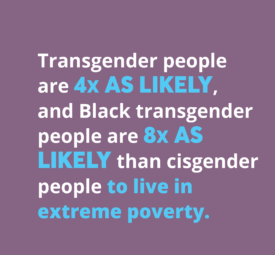
Transgender people are 4x as likely, and Black transgender people are 8x as likely than cisgender people to live in extreme poverty.
Source: Movement Advancement Project and Center for American Progress. February 2015. Paying an Unfair Price: The Financial Penalty for Being Transgender in America.

19% of trans and nonbinary people are uninsured.
Source: Koma, W., Rae, M., Ramaswamy A., Neuman, T., Kates, J., Dawson, L. (2020). “Demographics, Insurance Coverage, and Access to Care Among Transgender Adults.” Kaiser Family Foundation.
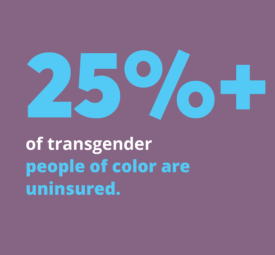
More than 25% of of transgender people of color are uninsured.
Source: Source: dickey, l. m., Budge, S. L., Katz-Wise, S. L., & Garza, M. V. (2016). Health disparities in the transgender community: Exploring differences in insurance coverage. Psychology of Sexual Orientation and Gender Diversity, 3(3), 275–282.
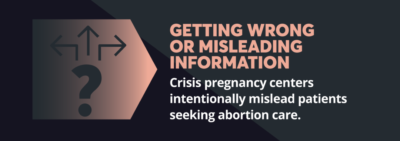
Getting Wrong or Misleading Information: Crisis pregnancy centers intentionally mislead patients seeking abortion care.
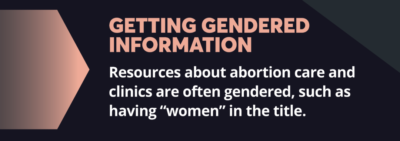
Getting Gendered Information: Resources about abortion care and clinics are often gendered, such as having “women” in the title.

Fearing Denial of Care: A quarter of transgender people are denied healthcare and 30% of transgender people delay healthcare because of discrimination.
Source: Jaffee, Kim D. PhD, MSW*; Shires, Deirdre A. MPH, MSW*; Stroumsa, Daphna MD, MPH† Discrimination and Delayed Health Care Among Transgender Women and Men, Medical Care: November 2016 – Volume 54 – Issue 11 – p 1010-1016.
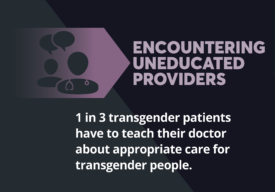
Encountering Uneducated Providers: 1 in 3 transgender patients have to teach their doctor about appropriate care for transgender people.
Source: James, S. E., Herman, J. L., Rankin, S., Keisling, M., Mottet, L., & Anafi, M. (2016). The Report of the 2015 U.S. Transgender Survey. Washington, DC: National Center for Transgender Equality

Encountering Abuse & Discrimination: Nearly half of transgender adults report being misgendered or treated roughly, facing abusive language, or another form of mistreatment.
Source: Medina, C., Santos, T., Mahowald, L., Gruberg, S. (August 18 2021) Protecting and Advancing Health Care for Transgender Adult Communities. Center for American Progress.

In 2011, there was only about 5 hours, on average, of LGBT related content among 150 medical schools, with transgender-related topics least addressed.
Source: Obedin-Maliver J, Goldsmith ES, Stewart L, et al. Lesbian, Gay, Bisexual, and Transgender–Related Content in Undergraduate Medical Education. JAMA. 2011;306(9):971–977. doi:10.1001/jama.2011.1255

Restrictions & Requirements: Existing laws impose restrictions, including requiring multiple visits to secure treatment.

Long Waits and Limited Staff: Existing providers can be overwhelmed and have long wait times.
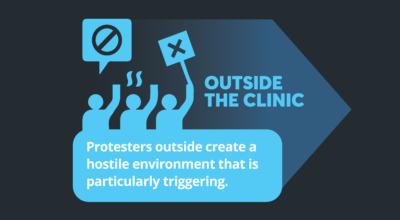
Outside the Clinic: Protesters outside create a hostile environment that is particularly triggering.

Inside the Clinic: Gendered environment inside the clinic (forms, deadnaming, brochures, etc) may create/cause/exacerbate gender dysmorphia.

Finding an abortion clinic and making an appointment is just the beginning.
It does not guarantee that patients will receive gender-affirming care.

According to Funders for LGBTQ Issues, for every $1 million awarded by the sector, just $400 are allocated for transgender/nonbinary people, with $88 set aside for transgender/nonbinary health and well-being, and just under $11.44 was for sexual and reproductive health for trans and nonbinary people. Meanwhile, each year about $448 of every $1 million given by US foundations goes just to Harvard alone.
Source: Wallace, A., Kan, Lyle M. (2020) 2018 Tracking Report: Lesbian, Gay, Bisexual, Transgender and Queer Grantmaking by U.S. Foundations. Funders for LGBTQ Issues.
Visit www.GUTC.org to learn more about philanthropic organizing to increase investments in transgender communities.
Editor’s Note: Source for stat on funding for Harvard University is from an NCRP analysis of Candid data.
Note: There is very limited research and information available about transgender people and healthcare in general so it is likely that these statistics represent an undercount of the population. Research about reproductive health and experiences often exclude transgender and nonbinary people. As a result, there is little comprehensive data about the experiences of transgender, non-binary people regarding abortion care, preferences, and experiences.
Credits:
Graphics Designed by Trevor Messersmith of 80east Design
Website Frame & Submenu by Black Digital Group
A convenient way to get the latest news and resources that help grantmakers maximize the impact on equity and justice
Sign me up for ROUNDUP now